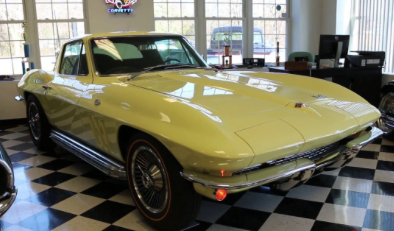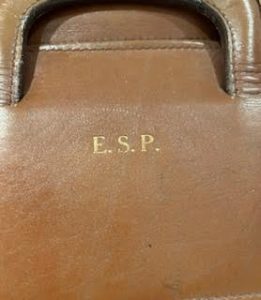
1966 Corvette Sting Ray
When I worked for ASI in Chicago in 1978, Indiana was my territory. General Motors was a national account, controlled by an account manager who had the relationship with the corporate office in Detroit, but I had several satellite accounts including Delco in Kokomo, an hour north of Indianapolis. My contact person was a mid-level manager named Dick Marshall, on whom I called early in my tenure with the company. He was tall, lanky, fair-haired. I had learned in my recent sales training to set my new contact at ease with the “warm-up”: ask some questions about what he liked to do and perhaps reveal a bit about myself as well.
I quickly learned that he was a classic Corvette aficionado. He collected, restored and showed them. His face lit up as he spoke of them. He invited me to have our next meeting at his home (right next to the plant), so he could show his collection to me. I accepted his offer.
As soon as I got home to my apartment, I called Dan in Boston (my resident car expert; yes, we were a commuting couple for 16 months) and asked him to tell me EVERYTHING about Vettes. There was no “google” 45 years ago. Dan complied and I learned a bit about GM’s finest sports car.
A few weeks later, Dick and I had a business meeting on the couch of his small living room. I instinctively felt I could trust him and that trust was well-placed. His home was not much bigger than the HUGE attached garage he led me to. It housed four cars: a white 1953 Corvette, in pieces all over a tarp, in the process of being restored; two red 1964 Vettes with a white insert, which were his every day, driving-around cars.
And the piece de resistance of his collection: a yellow, 1966 fully restored Sting Ray (like the one in the Featured photo). It was impeccable, PERFECT. You could eat off the engine block. This car, he showed in concourses and shows. It was his pride and joy. I was not allowed to touch it. He didn’t drive it. To transport it, he would put it up on a trailer.
We continued to have an excellent relationship for the nine months that I was in that territory and he signed a small contract with me. But he was up for a promotion that took him to Detroit. Housing costs were different there and he wound up selling off his collection. I think it broke his heart.
I was home in Detroit for Thanksgiving that year with my parents. I went over to my favorite cousin’s later in the evening. Her father, my dad’s oldest brother, had been the assistant comptroller of GM for years, though now long-retired. I told him my company wanted me to make a courtesy call at GM because of my familial connections. The man I was supposed to call on had been hired by Uncle Art (I think his name was Tom, but I’m not sure after 45 years). Uncle Art said it was fine to use his name when making the appointment.
And so, a few weeks later, I did just that, saying that Art Sarason’s niece, Betsy Pfau, would like to call on the gentleman to pay respects from ASI. I stayed with my folks and asked my dad how to get to the Renaissance Center, which was built long after I left the area (this event took place before GPS). Dad’s directions weren’t quite good enough and I was sailing past those towers, still on the highway, and had to figure out how to double back and find my way, but I did get there. I always allowed myself “getting lost” time.
I was shown into Tom’s office. He greeted me brusquely. “What is your relationship to Art Sarason?”, he demanded. I held up my briefcase, which had my monogram ESP embossed in gold letters (a going-away gift from my previous company), “Do you see that ‘S’? It stands for Sarason. Art is my uncle.” Well, the man became a pussycat, asked after my uncle, for whom he had great respect and the meeting went quite well.
After that, I visited Dick Marshall in the same building, just to say hi. He looked ashen, though he was certainly happy to see me. He was so unhappy to be in Detroit, missed his cars terribly (he was driving a Buick LeMans, heaven knows why). We talked about an hour. He felt he had made a big mistake, but there was no turning back. It was clear to me that he had left his heart and soul behind when he sold those Corvettes, even for a big corporate promotion. He had left perfection behind. I never heard from him again.
Retired from software sales long ago, two grown children. Theater major in college. Singer still, arts lover, involved in art museums locally (Greater Boston area). Originally from Detroit area.





Betsy, this is a well-told, cautionary tale with something in it for all readers: perfection is a subjective thing and differs for each of us. When we try to pursue any standardized definition of it, as Dick did in taking the corporate promotion in another city, we discover we misread the signs. We had it once and gave it up. Doesn’t mean we can’t go back to try retrieving it, though. I found that to be true in my life at age 49, and it worked!
I think Dick’s form of perfection was his ’66 Corvette. Getting ahead at GM, as you point out, didn’t do it for him, but he couldn’t retrieve what he loved most, as he had sold his car collection. Sometimes one cannot go back and pick up the pieces.
I am so happy to hear that were able, at the age of 49, to find your path and happiness. Good for you!
As Jim said, this was indeed a cautionary tale.
I can understand your friend Dick’s love of his Corvettes as altho I’m no where near a car buff I must admit I love our 2004 (!) Ford T-bird, and in fact wrote about it in my very first Retro story!
See
https://www.myretrospect.com/stories/fender-bender/
Yes, Dana. He gave up his great love to get ahead in the world, only to discover the it was not what he truly wanted.
While I know nothing about cars, I can relate to how this man gave up what he felt was a perfect life to accept a promotion that never made him happy.
Exactly so, Laurie. Sometimes our dreams are not what we really want. Those cars were his “perfection”.